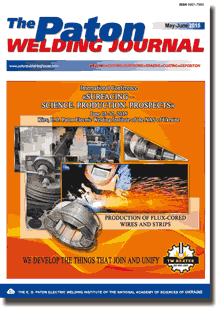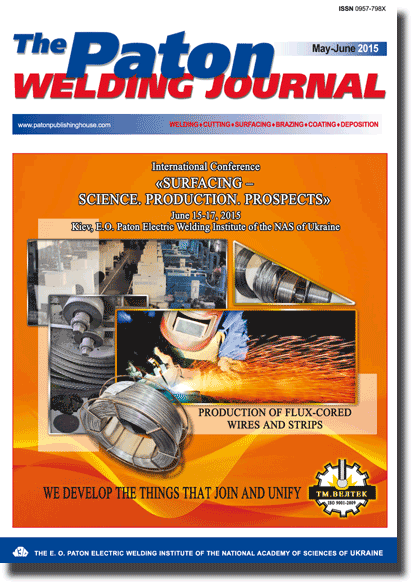| 2015 №06 (16) |
DOI of Article 10.15407/tpwj2015.06.17 |
2015 №06 (18) |

The Paton Welding Journal, 2015, #5-6, 78-82 pages
Structure and abrasive wear resistance of deposited metal hardened with carbides of different types
I.A. Ryabtsev1, A.I. Panfilov2, A.A. Babinets1, I.I. Ryabtsev1, G.N. Gordan1 And I.L. Babijchuk1
1E.O. Paton Electric Welding Institute, NASU. 11 Bozhenko Str., 03680, Kiev, Ukraine. E-mail: office@paton.kiev.ua
2«Steel Works» Company. 50 Mir Ave., of. 32, 50069, Krivoj Rog, Dnepropetrovsk Distr., Ukraine. E-mail: ogs@steel-work.net
Abstract
Wear resistance was studied at wearing by fixed and unfixed abrasive of metal deposited with PP-AN192 flux-cored wire (strengthened by titanium carbides) and by Hardface HC-O flux-cored wire (strengthened by chromium carbides). It is found that both the deposited metal types, despite the different total content of alloying elements (30 % for Hardface HC-O and 10 % for PP-AN192), have approximately the same wear resistance. Structure of deposited metal of both the types consists of martensite, small quantity of residual austenite and carbides of different composition. Here, the high wear resistance of metal deposited with PP-AN192 flux-cored wire is attributable to the fact that titanium carbide contained in it is greatly superior in terms of hardness and wear resistance to chromium carbides, hardening the metal deposited with Hardface HC-O flux-cored wire. 10 Ref., 4 Tables, 6 Figures.
Keywords: deposited metal, flux-cored wires, abrasive wear, wear resistance, microstructure, carbides
Received: 10.04.15
Published: 28.07.15
References
1. Livshits, L.S., Grinberg, N.A., Kurkumelli, E.G. (1969) Principles of alloying of deposited metal. Abrasive wear. Moscow: Mashinostroenie.
2. Khrushchov, M.M., Babichev, M.A. (1970) Abrasive wear. Moscow: Nauka.
3. Khrushchov, M.M., Babichev, M.A., Berkovich, E.S. et al. (1971) Wear resistance and structure of hard deposits. Moscow: Mashinostroenie.
4. Ryabtsev, I.A., Senchenkov, I.K. (2013) Theory and practice of surfacing works. Kiev: Ekotekhnologiya.
5. Pereplyotchikov, E.F., Ryabtsev, I.A., Vasiliev, V.G. et al. (2003) Structure and properties of high-carbon high-vanadium iron-base alloys for surfacing. Metallovedenie i Termich. Obrab. Metallov, 5, 36-40.
6. Ryabtsev, I.A., Kondratiev, I.A., Zhudra, A.P. et al. (2002) Flux-cored wires for surfacing developed in PWI. Svarshchik, 2, 34-35.
7. Ryabtsev, I.A., Kondratiev, I.A., Vasiliev, V.G. et al. (2002) Wear resistance of deposited metal of Fe-C-Cr-Ti-Mo alloying system. The Paton Welding J., 4, 45-48.
8. Kiffer, R., Benezowsky, F. (1971) Hard alloys. Moscow: Metallurgiya.
9. Frumin, I.I., Ryabtsev, I.A., Golovashchuk, A.I. (1974) Influence of structural transformations on wear resistance of U25Kh6T4M carbide steel. Avtomatich. Svarka, 9, 23-25.
10. Palatnik, L.S., Papirov, I.I. (1964) Oriented crystallization. Moscow: Metallurgiya.
Suggested Citation
I.A. Ryabtsev, A.I. Panfilov, A.A. Babinets, I.I. Ryabtsev, G.N. Gordan And I.L. Babijchuk (2015) Structure and abrasive wear resistance of deposited metal hardened with carbides of different types. The Paton Welding J., 06, 78-82.The cost of subscription/purchase order journals or individual articles
| Journal/Currency | Annual Set | 1 issue printed |
1 issue |
one article |
| TPWJ/USD | 384 $ | 32 $ | 26 $ | 13 $ |
| TPWJ/EUR | 348 € | 29 € | 24 € | 12 € |
| TPWJ/UAH | 7200 UAH | 600 UAH | 600 UAH | 280 UAH |
| AS/UAH | 1800 UAH | 300 UAH | 300 UAH | 150 UAH |
| AS/USD | 192 $ | 32 $ | 26 $ | 13 $ |
| AS/EUR | 180 € | 30 € | 25 € | 12 € |
| SEM/UAH | 1200 UAH | 300 UAH | 300 UAH | 150 UAH |
| SEM/USD | 128 $ | 32 $ | 26 $ | 13 $ |
| SEM/EUR | 120 € | 30 € | 25 € | 12 € |
| TDNK/UAH | 1200 UAH | 300 UAH | 300 UAH | 150 UAH |
| TDNK/USD | 128 $ | 32 $ | 26 $ | 13 $ |
| TDNK/EUR | 120 € | 30 € | 25 € | 15 € |
AS = «Automatic Welding» - 6 issues per year;
TPWJ = «PATON WELDING JOURNAL» - 12 issues per year;
SEM = «Electrometallurgy Today» - 4 issues per year;
TDNK = «Technical Diagnostics and Non-Destructive Testing» - 4 issues per year.


